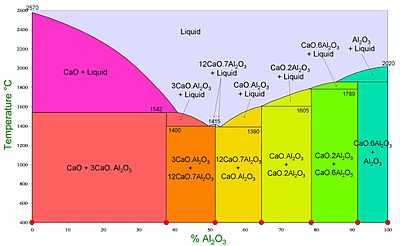Calcium aluminates
From Wikipedia, the free encyclopedia

Calcium aluminates phase diagram.
Calcium aluminates are a range of minerals[1] obtained by heating calcium oxide and aluminium oxide together at high temperatures. They are encountered in the manufacture of refractories and cements.
The stable phases shown in the phase diagram (formed at atmospheric pressure under an atmosphere of normal humidity) are:
- Tricalcium aluminate, 3CaO·Al2O3 (C3A)
- Dodecacalcium hepta-aluminate, 12CaO·7Al2O3 (C12A7)
- Monocalcium aluminate, CaO·Al2O3 (CA) (mayenite)
- Monocalcium dialuminate, CaO·2Al2O3 (CA2)
- Monocalcium hexa-aluminate, CaO·6Al2O3 (CA6)
In addition, other phases include:
- Dicalcium aluminate, 2CaO·Al2O3 (C2A), which exists only at pressures above 2500 MPa.[2] The crystal is orthorhombic, with density 3480 kg·m−3.
- Pentacalcium trialuminate, 5CaO·3Al2O3 (C5A3), forms only under an anhydrous and oxygen free atmosphere. The crystal is orthorhombic, with a density of 3067 kg·m−3. It reacts rapidly with water.
- Tetracalcium trialuminate, 4CaO·3Al2O3 (C4A3), is a metastable phase formed by dehydrating 4CaO·3Al2O3·3H2O (C4A3H3).
See also
- Cement
- Cement chemist notation (CCN)
in which the following abbreviations for calcium and aluminium oxides are defined as:- C = CaO
- A = Al2O3
References
- ↑ Taylor H.F.W (1990) Cement Chemistry, Academic Press, ISBN 0-12-683900-X, pp 34-38.
- ↑ Taylor H.F.W (1990) Cement Chemistry, Academic Press, ISBN 0-12-683900-X, p. 28, 29.
This article is issued from Wikipedia. The text is available under the Creative Commons Attribution/Share Alike; additional terms may apply for the media files.